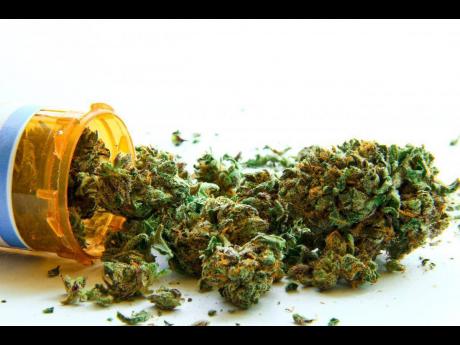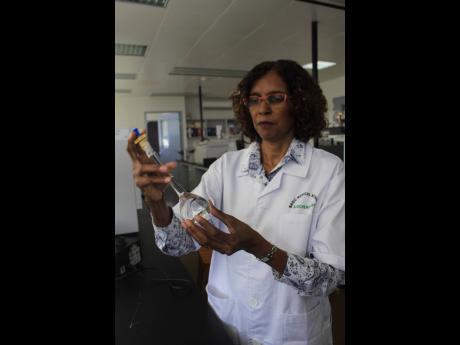Higher grade warning
Researchers say psychoactive component in locally grown marijuana is increasing
The potency of marijuana since its decriminalisation in 2015 has reportedly increased threefold, which may give some users higher doses than they can manage, a chief researcher at the Caribbean Toxicology Unit (CARITOX) at The University of West...
The potency of marijuana since its decriminalisation in 2015 has reportedly increased threefold, which may give some users higher doses than they can manage, a chief researcher at the Caribbean Toxicology Unit (CARITOX) at The University of West Indies (UWI), Mona, is cautioning.
The findings of a study into the potency of the herb will be officially released in a scientific journal later this year, but UWI lecturer Carole Lindsay is convinced that if left unchecked, the problem can create serious public health and regulatory concerns for the local medical marijuana industry.
The study canvassed hundreds of products from local ganja farmers and other marijuana interests, who, since 2015, have been providing samples to CARITOX, a unit within the Department of Basic Medical Sciences.
It was discovered that the potency level of the THC or Tetrahydrocannabinol in the cannabis has been steadily increasing.
THC is among the principal and most sought-after medicinal and psychoactive substances in the weed, and its potency is measured by its ratio with other non-psychoactive substances.
Local ganja cultivators have seemingly been manipulating the growing conditions to increase the strength and ratio of the THC, the researchers observed.
CARITOX’s findings coincide with potency concerns in the United States and Europe in recent months, which also conducted their own research and made similar discoveries in those markets.
Experts say this underlines users’ inability to discern the strength and effect of the weed at outlets.
“If you go to a bar, for example, and you buy a drink of rum, you will always get a certain percentage of alcohol in it. That level of alcohol will never go up in that drink of rum because it is controlled,” Lindsay explained to The Sunday Gleaner last week.
“But, if you think of it, we have these (marijuana) dispensaries where you go and buy yourself a joint. Today, you smoke and it is of a certain value and then you come back in six months’ time and it is twice the amount of THC in there. Twice the potency. That is serious. And somebody needs to monitor that,” she argued.
CARITOX is one of three authorised laboratories by the Cannabis Licensing Authority (CLA), the primary watchdog over the juvenile industry in Jamaica. Lindsay’s team is among the first attempting the lengthy process to create a profile of locally grown marijuana.
CHANGES OVER LAST DECADE
“In this study, the cannabinoid content of Jamaican-grown cannabis was examined over the period 2015 to 2020. Over 200 herbal cannabis samples were collected from various locations across the island,” read a synopsis of the extended paper.
“Of the 12 parishes studied, the highest average TCH (greater than 20 per cent) was detected in the central county of Middlesex. The results reported in this study suggest that, like other countries worldwide, Jamaica has seen an increase in the potency of locally grown strains over the decade,” it underscored.
Lindsay said greater details of the ‘potency paper’, regarding the other counties and parishes found with the most potent strains, are to come later this year. She also could not say yet the extent to which this increasingly potent marijuana was being sold on the market.
Nevertheless, she said, “it would be beneficial for the Government to implement a potency monitoring programme so as to manage these findings before they manifest into a cause for widespread health concern”.
MEDICAL INTERVENTION
“If there was a standard amount of THC that was delivered in a spliff and that is now increasing threefold, the psychiatrists need to weigh into that,” said Lindsay. “It is fine we started the medical marijuana industry and we are making money, but we don’t want to have people getting psychiatric events or problems.”
Not only is THC damaging to the development of brains in young adults, who are among the highest users of ganja worldwide, studies have shown that it also causes anxiety, paranoia and depression, and can also worsen other mental health illnesses such as schizophrenia in some.
“I am certainly all for the medical marijuana industry, but we need to move it a step further and the science is there to help us,” said the researcher.
On Friday, consultant psychiatrist Professor Wendel Abel suggested that the local ganja potency may be much stronger than unearthed so far, noting the damaging and addicting effects on some users, particularly teenagers, who have increased access to other illegal forms of marijuana consumption, including edibles and vaping.
“What we need is public health intervention because we know that when we decriminalised we would have products of increased potency,” relayed Abel. “The positive aspect is that medical marijuana is available, but if we are not monitoring the potency of products, they (users) may not know what they are actually consuming,” he offered.
Abel added, “With increased potency, we need to ensure that we are monitoring products on the market. Nothing is wrong with the farmers doing that (increasing potency); what we want to ensure is that products coming on the market for medical use are properly labelled and people know exactly what they are taking, and its potency.”
POTENCY BOOST GOOD
Not all find the potency issue a problem, including CLA chairman Levaughn Flynn. Increased marijuana potency is good, he said in response to Sunday Gleaner questions last Thursday.
“This (increased potency) should be seen as good, as the plant is producing more of the chemical compounds that are needed for medicinal and therapeutic purposes,” Flynn outlined, adding that he has not yet received any data indicating an increase in potency locally.
He admitted, however, that “the global trend does show that cannabinoid levels in the plant have been increasing. That is attributed to the use of cultivation and post-harvesting best practices that the regulated industry requires.”
As it is, there are no restrictions locally as to the potency level of ganja produced by licensed distributors. That is not established practice in the global industry, he said, adding that the Authority retains its right to collect and test samples in the local market.
“Additionally, the Natural Health Products Bill being led by the Ministry of Health, which will govern the production of cannabis value-added products, will stipulate specific labelling requirements, which include a cannabinoid profile on all packaging,” he offered. “This is a sector of the industry the CLA is excited about, as it will allow more Jamaicans to access cannabis products safely while offering a variety of consumption modes.”
President of the Ganja Growers and Producers Association, Richard ‘Dickie’ Crawford, was more concerned about the findings.
“One would not refute or would want to treat the findings lightly from the tremendous amount of research and work. If that has come up in scientific research, we would want to go even further to determine the most accurate responses that we get,” Crawford emphasised.
“My take away would be that there definitely needs to be more testing of cannabis sold in retail spaces and labelling so people are more informed about what they are buying and consuming.”
Once CARITOX’s research paper is complete, it will be presented to the relevant government authorities to examine the findings.






